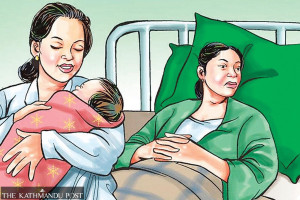Opinion
Health insurance intricacies
Upon endorsement of the National Health Insurance Policy in 2013, the Ministry of Health and Population formed the Social Health Security Development Committee in February 2015 as a legal framework to oversee Nepal’s health insurance programme and to ensure appropriate implementation of universal health care within three years.
Dr Manoj Bhattarai
Upon endorsement of the National Health Insurance Policy in 2013, the Ministry of Health and Population formed the Social Health Security Development Committee in February 2015 as a legal framework to oversee Nepal’s health insurance programme and to ensure appropriate implementation of universal health care within three years. However, the enrolment process has been anything but a cakewalk in a country where there is rising unemployment, an age-dependency ratio of approximately 61.8 percent, and where 25 percent of the population lives below the poverty line
Identifying complications
The main challenge in the pilot phase of the policy has been low enrolment in various districts, which is attributable to factors such as availability of already free health care services (related to maternal health, uterine prolapse, heart disease, kidney disease and cancer treatment) and essential drugs as well as a lack of understanding and awareness among people that insurance leads to lower out-of-pocket health care spending in the long run. Its success will hang in the balance until issues of unequal distribution of health care services in different geographic locations, limited resources (material and human), inadequate supply of essential drugs and a disorganised information technology sector are resolved. Resolving these issues is instrumental in delivering quality health care services, monitoring providers’ performance and designing efficient payment systems for a functional system.
Inadequate enrolment is a problem even in developed countries where the state can impose tax penalties on citizens who opt out of health insurance. Nepal has a weak taxation system, so there is a need for ingenuity in separating individuals who can afford health insurance from those who need subsidies. In Nepal, for instance,
people with driving licenses should be able to afford health insurance. Similarly, students attending private schools and formal sector employees should all be directed to buy health insurance. However, students attending government schools, older adults living in elderly homes, people with disabilities who live in shelters and poor students would benefit from free health insurance.
There are only three proven ways to fund national health insurance and increase coverage: by raising general taxation, through voluntary enrolment and contribution of premiums, or by non-profit funding programmes. Finding a good fit for Nepali citizens would involve exploring these alternatives.
Three steps
Once adequate funding is available to run the national health insurance programme, the following steps would improve efficacy in service delivery.
First is the creation of singular units of an integrated electronic medical recording (EMR) system for health care providers, pharmacies, imaging centres and laboratories to communicate about and coordinate service delivery. This would minimise the fragmentation of care and lower costs. A robust EMR system would track performance of individual entities in a transparent manner. In fact, any payment system is bound to fail in the absence of timely provision of consistent data to help physicians and other providers improve and coordinate care while continuously evaluating, reporting and refining care processes. The United States exemplifies the downside of having too many electronic medical records and fragmented systems that have translated to comparatively poorer health outcomes despite recording the highest per capita health care spending in the world ($9,000).
Step two would involve the design of a universal health care system that improves the quality of service and efficiency of care by lowering cost and rewarding value. The fee-for-service approach, widely practised in Nepal, is a global system that incentivises volume of care rather than value of care. Its inefficiency and ineffectiveness lie in the failure to control cost for patients and insurance systems. Providers benefit by ordering more diagnostics (lab tests and imaging) and performing unnecessary procedures to increase volume.
A more efficient system is a capitated one where insurance providers specify the sum of money per person to the network of providers covered by a health entity. However, the problem is that providers can often delay the delivery of necessary health care to patients. For example, a provider network receiving Rs2,500 per patient for 1,000 patients can save more money by delaying care to the next year, by providing services to only 600 patients, or by not ordering CT scans or referring a patient to a surgeon when required. A capitated payment system rewards providers for spending less but not specifically for improving outcomes or value. Therefore, quality indicators of service delivery are essential to ensure that patients receive required care.
A bundled payment system is the most effective system designed so far, where a lump sum is paid for an entire episode of care; for example, Rs4,000 is channelled towards in-patient treatment of pneumonia. Under this system, it is up to a provider to decide the range of services to offer in an effort to save money while providing excellent care. Bundled payment of, for example, Rs2,500 per year, can be provided for surgical procedures such as appendectomies or overall care of chronic ailments, diabetes or hypertension. The key to the system’s success lies in the ability to assess outcomes closely and to penalise providers for inadequate care. For example, a patient with heart failure who needs five days of in-patient care can be discharged in two days by a provider intent on saving money. An insurance company can penalise such a misdeed by failing to pay a provider for a repeated service if the patient is readmitted to hospital within 30 days. In Nepal, the bundled payment system may help alleviate the leading causes of child and adult mortality.
Third, in order to lower costs while delivering quality care, a group of physicians, hospitals, imaging centres, pharmaceuticals, labs and other ancillary services can work in concert by forming a legal entity in each federal state that would be jointly held accountable for overall care. This is the American equivalent of the Accountable Care Organisation whose successful model fosters quality at reduced costs while supporting innovation. Investors in individual federal states and non-profits should be allowed to incorporate such organisations for integrated care. These organisations would handle the bulk of preventive and screening services such as routine immunisation, age-appropriate cancer screening, and surveillance of hypertension, diabetes and lipid control.
A thoughtfully designed health care insurance and payment system not only improves overall health, but is also a source of employment for thousands of computer engineers and other professionals. Whereas the jury is still out on the most effective system to implement, universal health care in Nepal need not be a pipe dream if there is a sound and actionable legal framework in place.
Bhattarai is a practising nephrologist in Florida, the US and a general secretary of Health Foundation Nepal, a non-profi




 13.12°C Kathmandu
13.12°C Kathmandu











